Riding technique: The three scourges - how to prevent spinouts, wheelies and catapults
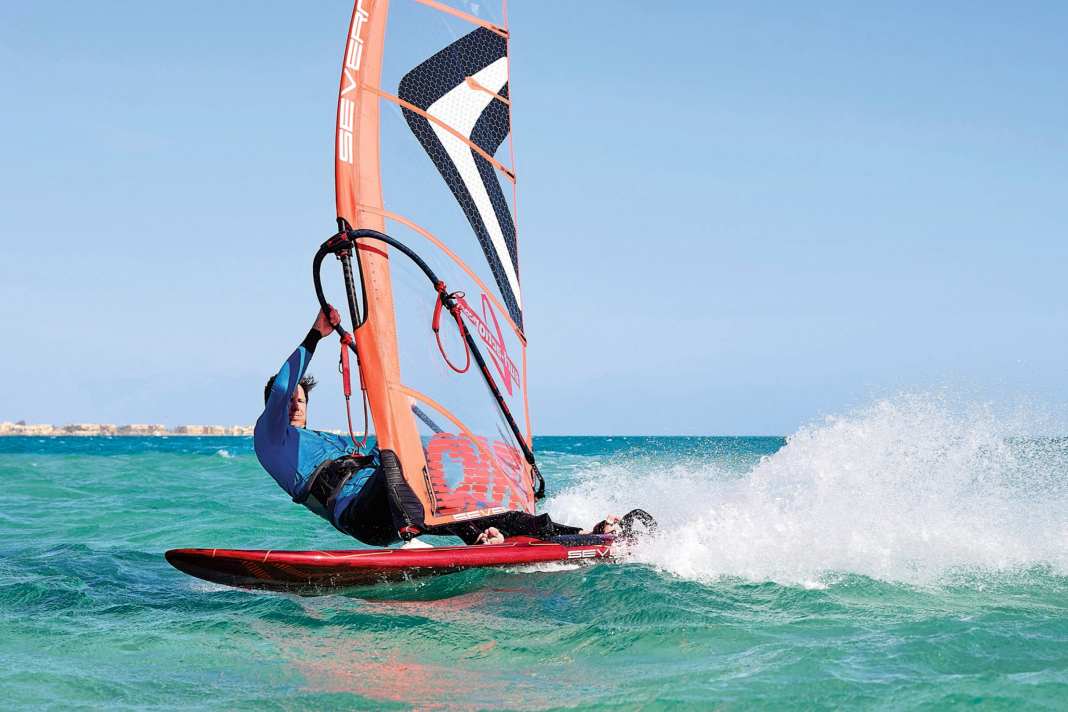





Jeveryone knows them, nobody wants them: spinouts, wheelies and catapults! Whether you're a beginner or a pro - nobody is safe from the three scourges of windsurfing. There are many reasons for control problems - in addition to external circumstances such as strong gusts or an overlooked choppy wave, riding errors are one of the most common causes. To a certain extent, a well-kept "skid" is also simply part of it and not every fall means that you have to change something fundamentally. The important thing is simply to know what the cause is if the board keeps rising unintentionally or the fin breaks out. If the nose of your board comes off in every second gust, you slide from spinout to spinout on the cross or you've already written to the board repairer because of all the catapults, it's definitely worth taking a closer look at your own equipment set u-p. Because with the right adjustments, you can get yourself and your equipment into the right balance.
Luff trim, base plate, boom height, fin - adjustments make sense in this order."
Balancing act
Windsurfing is a technical sport, and there are several levers that have a big impact on the feeling of gliding. The aim is to achieve a planing position in which the board dances across the water freely and without sticking, without taking off, pinching or breaking away. In general, the aim is always to transfer the power of the sail to the board in such a way that a kind of equilibrium is achieved, making it possible to surf with equal traction distribution on both arms and approximately equal pressure distribution on both legs.
There are certain adjustment screws that - turned in one direction - ensure that you get the feeling of more power, i.e. a sporty, flying ride. Turned in the other direction, on the other hand, the adjustments ensure more control, i.e. a calmer water position of the board.
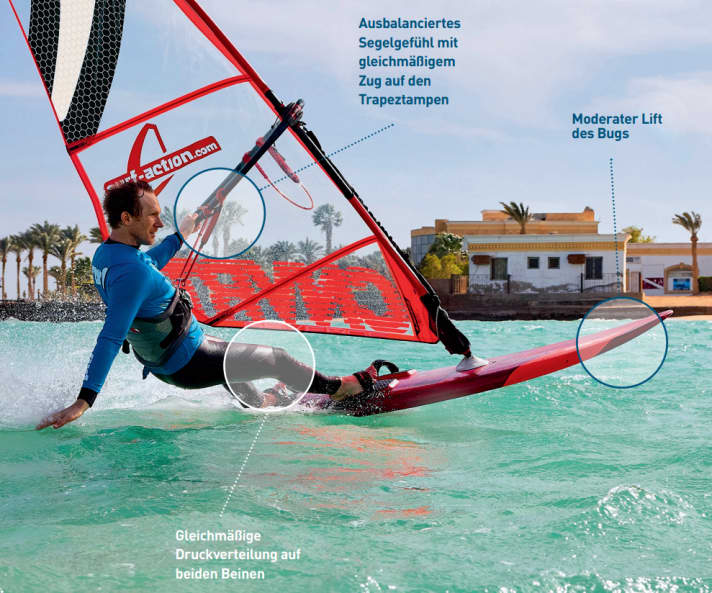
The most important levers are:
- Sail trim
- Boom height & rope length
- Fin length
- Mast foot position
- Loop position
It is important to know that certain measures can solve a certain problem but exacerbate another. A good example is fin length: frequent spinouts can be a sign that the fin is too small. Changing to a larger fin will give the board more tail guidance, but in strong gusts it will also have so much lift that you can have problems with the bow lifting off ("wheelie"). So it's all about finding the right balance between surfer and equipment. In the following, we will show you the most important adjustments for the various control problems - so that you can glide over the water this summer in a relaxed and energy-saving manner.
Equal traction on both arms and almost equal pressure on both legs - that's the ideal state you're looking for when gliding."
How to prevent your board from rising
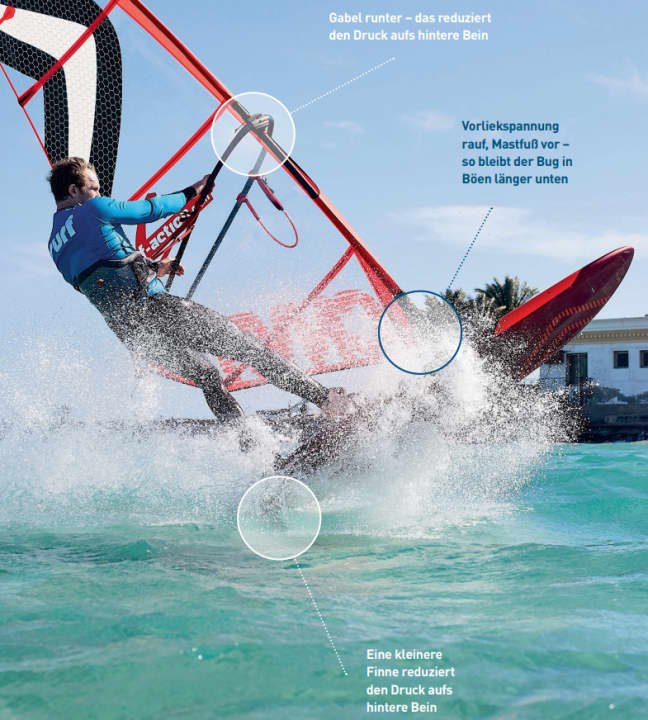
In biking, a wheelie is a planned action - with the front wheel in the air, this is one of the basics of every ambitious mountain biker. The situation is different in windsurfing, where you like to keep the board flat on the water. In strong gusts, however, the pressure on the back leg sometimes increases to such an extent that the board starts to become unsteady and, in the worst case, does a wheelie, causing the nose to rise uncontrollably - not a nice feeling. If such unwanted flight actions happen to you more often, changes to the set-up can provide a remedy. There are measures that can be implemented quickly and others that require more effort. They all aim to reduce lift and make your board glide in a more controlled manner. Here is your checklist for more control:
Keep the centre of effort at the front
The stronger the wind, the more the centre of effort of the sail shifts backwards and the greater the pressure on the back leg. In extreme gusts, the sail even becomes "windward" and you suddenly have to pull with your back hand while the mast is coming towards you at the front. The remedy in this case is more downhaul rope tension, as this opens the sail top, which allows pressure to escape and thus reduces the active sail area. More downhaul rope tension flattens the profile and the wind leading edge. This also reduces the sail pressure and the active pull forwards. But be careful: more downhaul rope tension and a flatter profile also changes the boom setting! If you set the sail further through the luff, you will normally also have to trim the boom slightly! Many sails offer two clew eyelets as an option. If there is a lot of wind, it is better to use the lower one, as the sail can then twist a little more freely in the leech and thus release steam better.
Boom lower, base plate (slightly) forward
Slightly shifting the boom downwards also brings some pressure from the rear leg and can thus help to prevent wheelies. Two to three centimetres are sufficient and have a clearly noticeable effect at the limit. However, you should bear in mind that many freeriders ride the boom too low and with harness lines that are too short anyway. Slightly pushing the base plate forwards also ensures that the bow stays down better. Starting from the centre position, however, one to two centimetres is sufficient. Under no circumstances should you push the base plate all the way forwards in the mast track!
Smaller fin
The last measure for recurring wheelies is to use a fin with less lift. Background: In order to plane well, most freeride boards are equipped with fairly large and thickly profiled fins. A fin that is three to four centimetres shorter than the standard fin massively expands the range of use. A softer fin or one with a thinner profile achieves the same effect.
Freeriders often don't do themselves any favours with straps mounted far out. It's harder to get in and the risk of spin-outs increases."
Preventing spinouts - the best tips
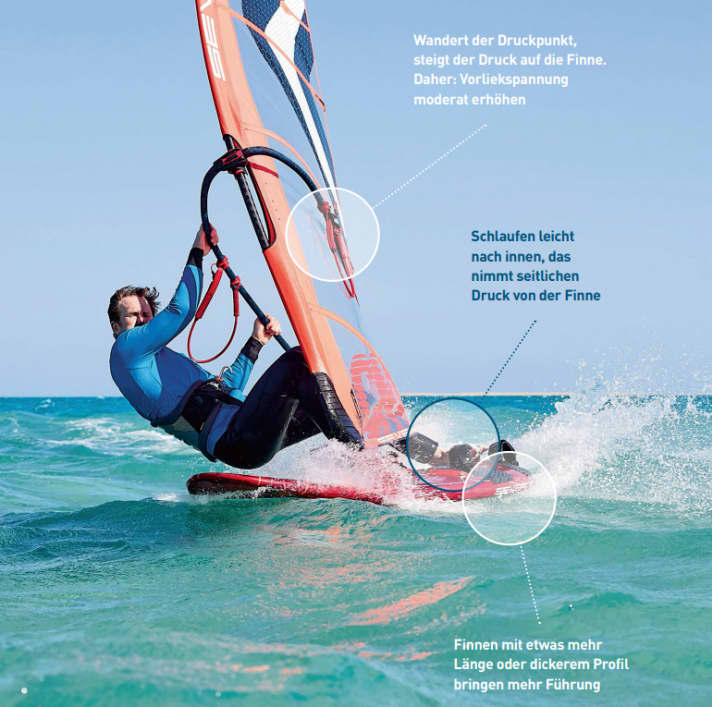
The spinout comes suddenly and unexpectedly and is about as popular as a toothache - it puts an abrupt end to gliding fun. It occurs when the current suddenly breaks off at the fin, causing the tail to slide uncontrollably downwind. On boards with small fins (e.g. wave or freestyle), the tail can be caught again quite easily, but freeride and freerace boards often require a complete restart - get out of the straps, start gliding again and watch your grinning mates disappear into the distance.
The majority of spinouts are avoidable if you make the right adjustments. The length and profile of the fin, the board trim via the position of the base plate and straps, the position of the centre of effort as a result of the sail trim and, of course, your own riding technique all have an influence on the frequency of spinouts.
Base plate in the centre
Many surfers who have problems with spinouts try to solve the problem by pushing the base plate forwards. On the face of it, this makes sense, as it also shifts the centre of effort forwards and takes pressure off the fin. However, the overall trim of the board and sail also suffers when the base plate is pushed completely forwards. The board will no longer glide freely and will be uncomfortable in chop, which can massively impair speed and control. The centre position therefore remains the clear recommendation.
Straps to the inside
If you ride the straps in a far-out position, you will also put a lot of lateral pressure on the fin. If you often struggle with spin-outs when planing, you will ride more comfortably with the straps in a slightly more inward position and even end up with a higher average speed.
Run at a controlled height
The board must have a solid planing speed to ensure a stable current at the fin. If you gain height too soon after planing and immediately build up pressure, you will encourage the tendency to spin out. Therefore: After stepping into the straps, first build up speed and then switch to a closehauled course in a controlled manner.
More downhaul rope tension
Spinouts often occur when you are travelling with large sails. These have a longer boom and therefore the centre of effort is further back, which increases the pressure on the fin. If the sail is also trimmed too bulbous, the centre of effort moves even further back. You can feel this when - in gusts, for example - the pull on the back hand increases sharply. This also increases the pressure on the fin and the risk of spinout increases.
surf tip: If the sail pulls on the back hand in gusts, pull the luff a centimetre further. Trim the outhaul rope only slightly flatter at first so as not to stifle the planing performance.
Longer fin
A longer fin is the last adjustment you can make. If the problem cannot be solved with trim, strap position and riding technique, a two to three centimetre longer fin can also make sense. Although fins with a thicker profile are usually a little slower than thin profiles, they are also less prone to spin-outs as the current is more stable here. Another plus: thick profiles are slightly more powerful in light winds and especially in the planing phase.
How to avoid catapults
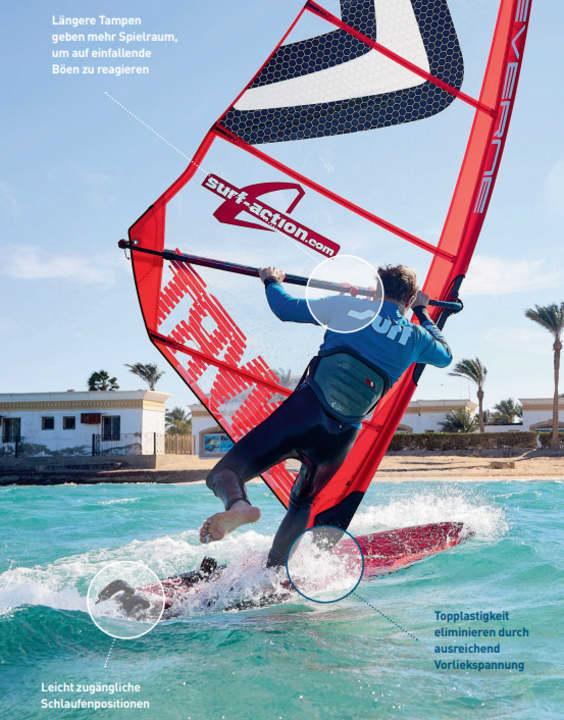
If the wind picks up, the power of the sail often builds up in the top and the rig feels heavy and top-heavy. This can also be recognised when you can observe visible cross-folds above the boom when pumping or crossing chop - a sure sign that the sail is under-trimmed.
The consequence of this is that the nose of the board is permanently pressed onto the water, especially when travelling downwind, and sets in choppy waves instead of flying freely over them. The result is a large wetted surface (a lot of water friction), which causes catapults in the event of small errors. A base plate mounted too far forward can also exacerbate this problem - the centre position is the clear recommendation here.
Trim away top-heaviness!
If your sail compresses over the boom and cross-folds, more really is more! More downhaul rope and loose leech open up the sail at the top so that the centre of effort comes down and the sail feels lighter at the top. The board rides more freely and faster. Rigged with loose leech, it is important to only tension the boom moderately. The sail can touch the boom. This makes it more stable and smoother in the hand.
Use long ropes
Long ropes provide significantly more control. The body and therefore the centre of gravity are further away from the sail, so you have more time to react to chop or incoming gusts. This is the most important adjustment screw, especially if you repeatedly catapult during the planing phase. When fully powered up, you also benefit from long ropes because, to exaggerate a little, you can stick your bum out better, which brings the centre of gravity further out. With short harness lines, on the other hand, you automatically have a more stretched posture and are closer to the sail - with a correspondingly shorter reaction time in incoming gusts. Our tip: use vario harness lines with an adjustment range of 24 to 32 inches and gradually make the lines a little longer.
Optimise power transmission
If you regularly catapult when planing, make sure - in addition to the aforementioned long harness lines and a high boom - that your power transmission is directed forwards. To do this, turn your front foot clearly in the direction of travel, with your toes pointing towards the bow. This will push the board forwards over the sliding threshold instead of across it. A loop position that is easily accessible reduces the risk of skidding during the planing phase.

